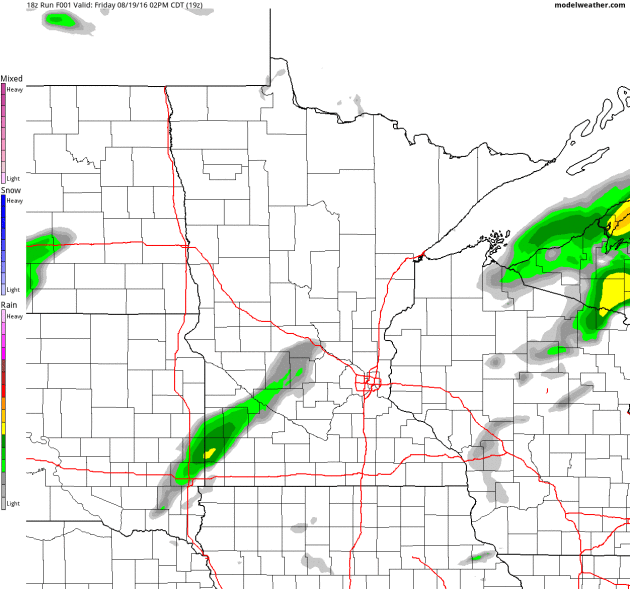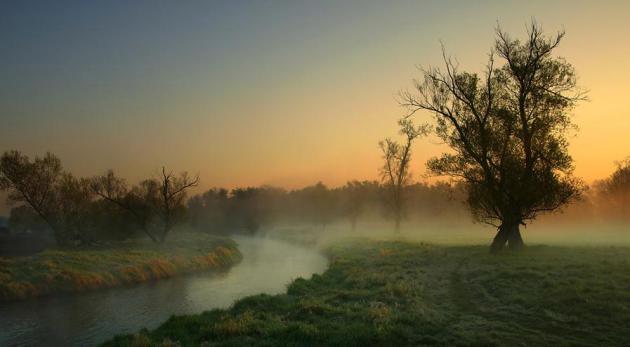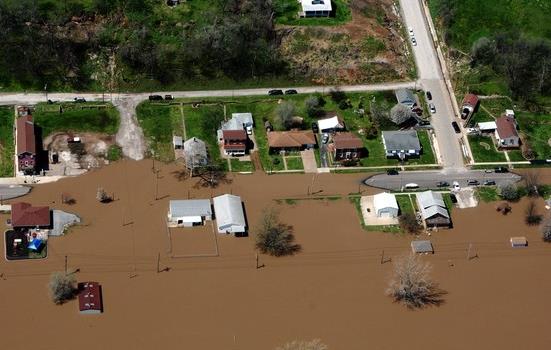80 F. average high on August 19.
65 F. high on August 19, 2015.
.34" rain fell at MSP International Airport yesterday.
August 20, 1904: Both downtown Minneapolis and St. Paul are hit by tornadoes, producing the highest official wind ever recorded in Minnesota over one minute (110 mph in St. Paul).
A Touch of "Aug-tober" - Sweatshirts Optional
Football is on the tube - it won't be long before I'm tracking big yellow school buses on Doppler and people-watching at the Minnesota State Fair. So why not cue up a cool front, just to remind us what cool feels like? By Sunday morning you may need to rummage around for a light jacket or sweatshirt. Goosebumps. What a concept.
A storm spinning up along the leading edge of brisk, Canadian air flushing south whips up more showers today, with temperatures stuck in the 60s and a whiff of wind chill after dark. Sunday looks MUCH nicer with sunshine, cotton-ball cumulus and afternoon highs in the low 70s. 80s return Monday and Tuesday, but models pull another puff of premature chill into Minnesota late next week; more random hints of autumn which spill into the last weekend of August.
Remind me not to complain. My colleagues in Los Angeles are trying to pinpoint wind speed & direction to help firefighters. Louisiana is facing a flood-related housing crisis. And the GFS model pulls a hurricane into Florida by August 31. I don't believe it yet - but what else can go wrong?

Cooler Than Average September? At some point the law of averages catches up with you and the weather swings in the opposite direction. We've been trending warmer than average for all of 2016; a mild La Nina cooling of the Pacific may pull cooler than average air into the Northern Plains and Upper Midwest next month, while temperatures continue to bake from Seattle to Anchorage. Source: NOAA CFS and WeatherBell.
Image credit: "Saturn, Mars, and Antares line up almost vertically on the evening of August 23 and 24, 2016. Have a look!" Credit: Sky & Telescope diagram.
It's Time To Adapt to Megafires. Gizmodo
has an excellent article analyzing fire trends and how we continue to
pay to knock down increasingly pervasive and catastrophic fires: "...Fire
is a natural part of the lifecycle of many ecosystems. But the changes
we’ve seen in the past decade—more fires, hotter fires, larger fires,
weirder fires—are not natural, and they are not going away. As more
people settle at the edge of wildlands, as invasive species transform
ecosystems, and as climate change promotes more exceptionally hot days,
mild winters, and dry summers, our planet is becoming a tinderbox. The
men and women fighting fire understand this. It’s on us to provide them
the tools and resources they need to adapt. “The effects of climate
change are fairly obvious to us as firefighters,” Gray said. “When
you’re used to seeing fire season last four months, and it starts
stretching to eight months, it’s something that’s ever present in your
mind..."
Artwork credit above: Sam Woolley.
Catastrophic Floods in Louisiana Have Caused Massive Housing Crisis. NPR reports: "...And
as NPR's Debbie Elliott reports, waters rose astonishingly high in
places that historically have not experienced flooding. "Even for a
state accustomed to natural disasters, this flood is like nothing
they've ever seen before," Debbie says. She spoke to Wayne Norwood, who
with his wife, Debbie, owns an antiques museum that was destroyed in the
flooding. The couple, both retired police officers, also had four
rental homes damaged in the disaster. "We have fire insurance, but we
don't have flood insurance because we're not in the flood zone," Wayne
Norwood tells Debbie. "And that's what happened to thousands of people..."
Photo credit: The Washington Post.
"They Didn't Warn You": Louisiana Disaster Reveals Deep Challenges in Flood Communication.
There was no formal tropical storm or hurricane to track or warn on.
Did the stalled tropical depression get the media time and attention it
deserved? Here's an excerpt from Jason Samenow at Capital Weather Gang: "...Some
Louisiana residents said they were completely caught off guard by the
severity of this extreme event. “With a hurricane, they kind of warn
you. But this, they didn’t warn you,” Jayda Guidry, a resident forced
from her home, told The Washington Post.
“We just thought it was raining.” Meteorologists knew this storm could
wreak havoc days before the first drops of rain. And they issued
strongly worded predictions. But now they are soul-searching, wondering
how the message could’ve been more forcefully conveyed and attained
greater reach..."
Photo credit: "A flooded baseball field at the Gonzales Civic Center in Gonzales, La., on Aug. 17." (Jeffrey Dubinsky via Reuters).
How Louisiana Plans to Rebuild After Historically Damaging Floods. Here's an excerpt of an interview at PBS NewsHour: "...Well,
FEMA will give up to $33,000 if you weren’t in a flood zone and had no
insurance, but the average — that’s the maximum you can get. The average
is about $7,500. We’re going to have to make up that difference with
volunteers and the giving of people from all over the country working
with nonprofits to help make those people back in their house and make
them whole. A lot of elderly people that had never flooded, lived in a
house 40 or 50 years, didn’t see the need or couldn’t afford the flood
insurance. So, those are — those are the ones that we’re really
concerned about...."
Extreme Floods May Be The New Normal. Scientific American explains: "...Over
the past year alone, catastrophic rain events characterized as
once-in-500-year or even once-in-1,000-year events have flooded West
Virginia, Texas, Oklahoma, South Carolina and now Louisiana, sweeping in
billions of dollars of property damage and deaths along with the high
waters. These extreme weather events are forcing many communities to
confront what could signal a new climate change normal. Now many are
asking themselves: Are they doing enough to plan for and to adapt to
large rain events that climate scientists predict will become more
frequent and more intense as global temperatures continue to rise? The
answer in many communities is no, it’s not enough..." (File photo: U.S. Coast Guard).
Hurricanes and Tornadoes Have Them, Is It Time For a Flood Scale? Dr. Marshall Shepherd has food for thought at Forbes: "...Dr. Amanda Schroeder, informed me that their NSF-sponsored SPREAD working group, conceived by Colorado State’s Dr. Russ Schumacher,
recently published a paper proposing a flood severity index. Dr.
Schroeder, a hydrometeorologist with the National Weather Service Fort
Worth, emailed me and said, "I led an interdisciplinary group of young
scientists to develop a flash flood severity scale that goes beyond
confusing return periods and mere historical recollections of past flood
events. This new scale will be applicable across multiple geographic
locations and should provide an easy-to-follow frame of reference for
flood ratings and comparisons"...
13 Years After Northeast Blackout, U.S. Power Grid Remains Vulnerable. Here's an excerpt from a Wall Street Journal article: "...A coordinated attack on just nine of the nation’s 55,000 electrical substations could cause a blackout across the country, a Federal Energy Regulatory Commission report found in 2014. Through the American Recovery and Reinvestment Act, the Energy Department has spent $4.5 billion over the past few years to modernize the electrical grid. Most of that funding, which was more than matched by private dollars, went to “smart grid” efforts, with a notable focus on energy storage and creating stable power in multiple locations. This is just the beginning of what’s needed for infrastructure nationally if the goal is a decentralized (and, ultimately, renewable) electrical grid that ensures power even under extreme conditions..."
Photo credit: "Cars try to navigate through New York City as the sun sets during a blackout on Aug. 14, 2003." Photo: Associated Press.
Photo credit: "The tundra in Yakutia normally melts to a depth of 30-60cm, but this year it has reached a meter." Rex Features.
Exxon Mobile Fraud Inquiry Said To Focus More on Future Than Past. Here's an excerpt from a New York Times story: "...But
in an extensive interview, Mr. Schneiderman said that his investigation
was focused less on the distant past than on relatively recent
statements by Exxon Mobil related to climate change and what it means
for the company’s future. In other words, the question for Mr.
Schneiderman is less what Exxon knew, and more what it predicts. For
example, he said, the investigation is scrutinizing a 2014 report
by Exxon Mobil stating that global efforts to address climate change
would not mean that it had to leave enormous amounts of oil reserves in
the ground as so-called “stranded assets...”
File photo: Mike Mozart.
Photo credit: "An electric Tesla car recharges on the banks of a canal in Amsterdam. The Netherlands saw an all-time high in electric cars in December this year." Rex Features.
Bigger, Better, Cheaper: Wind Power is Flourishing in the U.S. Dave Roberts reports for Vox; here's the intro: "Here’s some good news for your weekend: Wind power is kicking ass in the US. That is the TL;DR version of the annual Wind Technologies Market Report
just released by the US Department of Energy and Lawrence Berkeley
National Laboratory (LBNL). With 73,992 MW, the US is now the No. 2
country in the world in installed wind capacity (after China, which has a
mind-boggling 145,053 MW).
And we are No. 1 in actual wind electricity generated. All that wind
only provides about 5.6 percent of US electricity, though, which puts us
well behind leaders like Denmark (40 percent), Portugal, Ireland, and
Spain (between 20 and 30 percent)..." (File photo: Shutterstock).
Beyond Coal: Imagining Appalachia's Future. Another hopeful article about reinvention from The New York Times: "Here
in the heart of central Appalachian coal country, an economic
experiment is underway inside an airy renovated Coca-Cola bottling
plant. Most days, Michael Harrison, a former mine electrician and “buggy
man” who once drove trucks 700 feet underground, can be found hunched
over a silver laptop, designing websites for clients like the Pikeville tourism board. Mr. Harrison, 36, is one of 10 former mine workers employed at BitSource,
an internet start-up founded by two Pikeville businessmen determined to
prove a point: that with training and encouragement, Kentucky miners
can learn to code..."
Photo credit: "Mountaintop
removal in Virginia as seen from Black Mountain in Kentucky. Pikeville,
Ky., is among the central Appalachian towns working to diversify their
economies as the coal industry fades." Credit George Etheredge for The New York Times.
The Cheapest Places to Travel For Each Month of the Year. Travel + Leisure has some news you can use: "You’ve heard the myths: Tuesday is the best day to book airfare. Wednesday is the best day to fly. January is the cheapest month to travel. All of them are up for debate, to a certain extent. But according to new data from Booking.com, you can count on getting good hotel values by picking the right destination for the right time of year. If a cheap vacation
is what you’re after, plan your trips based on when hotel rates are
proven to be low; then use a service like Hopper or Kayak to find the
best-priced plane tickets to round out your plans..."
Image credit: "Cleveland's Public Square in the 1910s." (Photo: Public domain)
“If you can't be a good example, then you'll just have to serve as a horrible warning.” – Catherine Aird

TODAY: Cool and showery with a damp, annoying wind. Winds: NW 10-20. High: 67
SATURDAY NIGHT: Showers taper, clearing late - brisk! Low: 54
SUNDAY: Partly sunny, the nicer outdoor day of the weekend. Winds: NW 8-13. High: 73
MONDAY: Plenty of sunshine, gusty and warmer. Winds: S 10-20. Wake-up: 61. High: 82
TUESDAY: Sticky sunshine, feels like summer. Winds: S 10-20. Wake-up: 68. High: 87
WEDNESDAY: Few showers, grumbles of thunder. Winds: NW 8-13. Wake-up: 69. High: 79
THURSDAY: Mostly cloudy, brisk wind. Winds: NW 10-20. Wake-up: 61. High: near 70
FRIDAY: Partly sunny, fresh air. Winds: NW 5-10. Wake-up: 56. High: 75
Climate Stories...
Historical Data Shows Arctic Melt of Last Two Decades is "Unprecedented". Here's an excerpt from InsideClimate News: "...Now, scientists have compiled the most detailed study to date
of sea ice records going back more than a century and a half. The data
shows that the rapid meltdown that satellites have been documenting
since 1979 is unprecedented since at least 1850 and coincides with the
buildup of heat-trapping greenhouse gases in the atmosphere from burning
fossil fuels. Arctic sea ice has not been at levels as low as today's for at least 5,000 to 7,000 years, according to Julienne Stroeve, a researcher with the National Snow and Ice Data Center (NSIDC), who was not involved in the study.
"It may have been sometime during the mid-Holocene, based on driftwood
found in Greenland that came from Siberia," she said. "Some other
studies have suggested at least 800,000 years..."
Image credit: "A gridded database of Arctic sea ice extending back to the 1800s."
Enlist the Market in the Climate-Change Fight. Here's the intro to an Op-Ed at The Wall Street Journal: "Even before the devastating flooding began in Louisiana last week, and we learned that July 2016
shattered all global temperature records, mounting data had
demonstrated the growing risks climate change poses to the global
economy. Whether you are an investor assessing the $2 trillion in bonds
that Moody’s
found carry elevated near-term climate risk, one of the nearly two
million U.S. homeowners facing significant risk from climate-related
flooding, or a U.S. taxpayer staring at $360 billion in direct
government costs from extreme weather over the past decade—these threats
are looming, large and increasing. This year’s World Economic Forum Global Risks Report declared the “failure of climate-change mitigation and adaptation” the “risk with the greatest potential impact in 2016...”
Climate Change Will Redraw Louisiana's Flood Risk Maps. Here's an excerpt from Newsweek: "...And
FEMA is going with another, more direct way of managing the increasing
risks of climate change: encouraging more severe weather-resistant
infrastructure. Some of the funds FEMA provides for a disaster go
towards rebuilding cities and houses to stricter code and in areas that
aren’t quite so risky—say, at higher elevations or further away from the
ocean. “Instead of constantly rebuilding for the next disaster, it’s
much smarter to use federal dollars to build safer and build back,” says
Lemaitre. As climate change risks climb and insurance costs rise to
reflect reality, the shoreline of Louisiana will change, too: fewer
buildings on the coast, and a lot more houses on stilts."
Photo credit: "
Space, Climate Change, and the Real Meaning of Theory. Here's an excerpt of an excellent essay from Piers Sellers at The New Yorker: "...Climate-change deniers in the United States have done a first-class job in spreading confusion and misinformation. As a result, many prominent politicians insist, and get away with insisting, that climate change is a hoax, a mantra that has gained some credibility through sheer repetition. Climate deniers are also fond of saying that global warming is not resolved in science or is “just” a theory. This is a perfect example of Orwellian Newspeak which also flies in the face of three hundred years of scientific progress, in which intellectual argument and conviction must be based on facts and substantiated theories, rather than personal beliefs or biases. It is also dangerous. If nothing is done to reduce carbon emissions over the next couple of decades, our climate models predict that there will be massive changes in the global precipitation and temperature patterns, with huge effects on water and food security, and dramatic sea-level rise..." (Image credit: NASA).
In a Warming World, Deluges Like Louisiana's Expected to Increase. InsideClimate News has the story: "...The
devastating rainstorm that unleashed terrifying flooding last weekend
in Louisiana, with thousands of people escaping their homes and whole
parishes being overtaken by water, comes in recent succession to
similarly extreme and deadly storms across the country—in Texas,
Maryland, West Virginia and South Carolina. These intense storms have
become seemingly commonplace, raising questions about climate change's
role.
Of the two factors that made Louisiana's storm so devastating, one
(increased moisture in the air) wears the fingerprints of man-made
climate change from mostly fossil-fuel burning, while the other (how
slowly the storm was moving) is not so easily explained..."
Image credit: "Flooding devastated area in Port Vincent, Louisiana along the Amite River southeast of Baton Rouge." Credit: NOAA Remote Sensing Division.

Climate Change Is Going To Bring More Floods Like Louisiana. We're Not Ready. Here's a clip from an analysis at Vox: "...Though
smaller than the devastation wrought by Hurricane Sandy in 2012, this
latest flood reminds us of what a changing climate has in store for us:
Places that have flooded before will flood again, and places that
haven’t in the past will do so for the first time. These disasters are
the new normal — several other states are currently recovering from
disasters of their own. What has become painfully clear is that the
“emergency management system” in the United States does not have the
capacity to address all the needs. The systems we have in place to
mitigate, prepare for, respond to, and recover from these events do not
have the ability to deal with so many disasters at once. We can do
better..."
Photo credit: Reuters/Jonathan Bachman. "A casket is seen floating in flood waters in Ascension Parish, Louisiana, on Aug. 15, 2016."
No comments:
Post a Comment